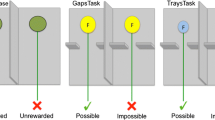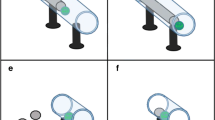Abstract
The trap-tube problem is used to assess whether an individual is able to foresee the outcome of its actions. To solve the task, an animal must use a tool to push a piece of food out of a tube, which has a trap along its length. An animal may learn to avoid the trap through a rule based on associative processes, e.g. using the distance of trap or food as a cue, or by understanding relations between cause and effect. This task has been used to test physical cognition in a number of tool-using species, but never a non-tool-user. We developed an experimental design that enabled us to test non-tool-using rooks, Corvus frugilegus. Our modification of the task removed the cognitive requirements of active tool use but still allowed us to test whether rooks can solve the trap-tube problem, and if so how. Additionally, we developed two new control tasks to determine whether rooks were able to transfer knowledge to similar, but novel problems, thus revealing more about the mechanisms involved in solving the task. We found that three out of seven rooks solved the modified trap-tube problem task, showing that the ability to solve the trap-tube problem is not restricted to tool-using animals. We found no evidence that the birds solved the task using an understanding of its causal properties, given that none of the birds passed the novel transfer tasks.


Similar content being viewed by others
References
Adams DC, Anthony CD (1996) Using randomisation techniques to analyse behavioural data. Anim Behav 51:733–738
Beck B (1980) Animal tool behavior: the use and manufacture of tools by animals. In: Garland series in ethology. Garland STPM, New York
Byrne RW (1995) The thinking ape: evolutionary origins of intelligence. Oxford University Press, Oxford
Chappell J (2006) Avian cognition: understanding tool use. Curr Biol 16:244
Chappell J, Kacelnik A (2002) Tool selectivity in a non-primate, the New Caledonian crow (Corvus moneduloides). Anim Cogn 5:71–78
Chappell J, Kacelnik A (2004) Selection of tool diameter by New Caledonian crows Corvus moneduloides. Anim Cogn 7:121–127
Cramp S, Perrins CM (1995) Handbook of the birds of Europe the Middle East and North Africa. Oxford University Press, New York
Emery NJ, Clayton NS (2004) The mentality of crows: convergent evolution of intelligence in corvids and apes. Science 306:1903–1907
Emery NJ, Seed AM, von Bayern AMP, Clayton NS (in press) Cognitive adaptations, neural mechanisms and the evolution of social bonding in birds. Phil Trans Roy Soc Lond B
Funk MS (2002) Problem solving skills in young yellow-crowned parakeets (Cyanoramphus auriceps). Anim Cogn 5(3):167–176
Gopnik A, Schulz L (2004) Mechanisms of theory formation in young children. Trends Cogn Sci 8:371–377
Hauser MD (1997) Artifactual kinds and functional design features: what a primate understands without language. Cognition 64(3):285–308
Hauser M, Krali J, Botto-Mahan C (1999) Problem solving and functional design features: experiments on cotton-top tamarins, Saguinus oedipus oedipuss. Anim Behav 57:565–582
Hauser M, Pearson H, Seelig D (2002) Ontogeny of tool use in cottontop tamarins, Saguinus oedipus: innate recognition of functionally relevant features. Anim Behav 64:299–311
Heinrich B (2000) A tiny, brainy bird. Nat Hist 109(1):8–8
Helme A, Call J, Clayton NS, Emery NJ (2006a) What do bonobos (Pan paniscus) understand about physical contact? J Comp Psychol 120(3):294–302
Helme A, Clayton NS, Emery NJ (2006b) What do rooks (Corvus frugilegus) understand about physical contact? J Comp Psychol 120(3):288–293
Humphrey NK (1976) The social function of intellect. In: Bateson PPG, Hinde RA(eds) Growing points in ethology. Cambridge University, Cambridge, UK, pp 303–317
Hunt GR, Gray RD (2002) Species-wide manufacture of stick-type tools by New Caledonian crows. Emu 102:349–353
Hunt GR, Gray RD (2004) Direct observations of pandanus-tool manufacture and use by a New Caledonian crow (Corvus moneduloides). Anim Cogn 7:114–120
Kacelnik A, Chappell J, Kenward B, Weir AAS (2006) Cognitive adaptations for tool-related behaviour in New Caledonian crows. In: Wasserman EA, Zentall TR (eds) Comparative cognition: experimental explorations of animal intelligence. Oxford University Press, Oxford
Lefebvre L, Nicolakakis N, Boire D (2002) Tools and brains in birds. Behaviour 139:939–973
Limongelli L, Boysen ST, Visalberghi E (1995) Comprehension of cause–effect relations in a tool-using task by chimpanzees (Pan troglodytes). J Comp Psychol 109:18–26
Manly BFJ (1997) Randomization, Bootstrap and Monte Carlo methods in biology. Chapman & Hall, New York
Mulcahy NJ, Call J (2006) How great apes perform on a modified trap-tube task. Anim Cogn 9:193–199
Parker ST, Gibson KR (1977) Object manipulation, tool use and sensorimotor intelligence as feeding adaptations in Cebus monkeys and great apes. J Hum Evol 6:623–641
Povinelli DJ (2000) Folk physics for apes: a chimpanzee’s theory of how the world works. Oxford University Press, Oxford
Santos LR, Pearson HM, Spaepen GM, Tsao F, Hauser MD (2006) Probing the limits of tool competence: experiments with two non-tool-using species (Cercopithecus aethiops and Saguinus oedipus). Anim Cogn 9:94–109
Seed AM, Tebbich S, Emery NJ, Clayton NS (2006) Investigating physical cognition in rooks (Corvus frugilegus). Curr Biol 16:697–701
Seibt U, Wickler W (2006) Individuality in problem solving: string pulling in two Carduelis species (Aves: Passeriformes). Ethology 112(5):493–502
Silva FJ, Page DM, Silva KM (2005) Methodological–conceptual problems on the study of chimpanzees’ folk physics: how studies with adult humans can help. Learn Behav 33:47–58
Spaulding B, Hauser M (2005) What experience is required for acquiring tool competence? Experiment with two callitrichids. Anim Behav 70:517–526
Sterelny K (2003) Thought in a hostile world: the evolution of human cognition. Blackwell, NewYork
Tebbich S, Bshary R (2004) Cognitive abilities related to tool use in the woodpecker finch, Cactospiza pallida. Anim Behav 67:689–697
Tebbich S, Taborsky M, Fessl B, Dvorak M (2002) The ecology of tool-use in the woodpecker finch (Cactospiza pallida). Ecol Lett 5:656–664
Tomasello M, Call J (1997) Primate cognition. Oxford University Press, New York
Visalberghi E, Limongelli L (1994) Lack of comprehension of cause–effect relations in tool-using capuchin monkeys (Cebus apella). J Comp Psychol 108:15–22
Visalberghi E, Tomasello M (1998) Primate causal understanding in the physical and psychological domains. Behav Process 42:189–203
Visalberghi E, Trinca L (1989) Tool use in the capuchin monkeys: distinguishing between performing and understanding. Primates 30:511–521
Weir AAS, Chappell J, Kacelnik A (2002) Shaping of hooks in new Caledonian crows. Science 297:981–981
Werdenich D, Huber L (2006) A case of quick problem solving in birds: string pulling in keas, Nestor notabilis. Anim Behav 71:855–863
Acknowledgements
S. Tebbich was supported by a Marie Curie Fellowship of the European Union under Contract No. HPMF-CT-2002–01599. A. Seed was supported by a BBSRC Postgraduate Studentship. N. Emery was supported by a Royal Society University Research Fellowship. This work was funded by the BBSRC, the Royal Society and the University of Cambridge. We thank R. Mundry for statistical advice and C. Teufel for conducting the Monte Carlo simulation, R. McCarthy and P. Meidl for help with collecting the birds, S. de Kort and K. Kluck for help with hand rearing, I. Millar for constructing the tubes, C. Donovan for bird care and the editor and anonymous reviewers for their comments on a earlier version of the manuscript. The rook nestlings were collected under N. Clayton’s English Nature Licence 20021292. This work adhered to University of Cambridge and UK Home Office regulations on animal husbandry and welfare.
Author information
Authors and Affiliations
Corresponding author
Rights and permissions
About this article
Cite this article
Tebbich, S., Seed, A.M., Emery, N.J. et al. Non-tool-using rooks, Corvus frugilegus, solve the trap-tube problem. Anim Cogn 10, 225–231 (2007). https://doi.org/10.1007/s10071-006-0061-4
Received:
Revised:
Accepted:
Published:
Issue Date:
DOI: https://doi.org/10.1007/s10071-006-0061-4




